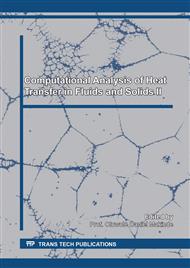[1]
P.O. Fanger, Thermal comfort, Danish Technical Press, Copenhagen, (1970).
Google Scholar
[2]
A. B. Howmik, R. Singh, R. Repaka, S. C. Mishra, Conventional and newly developed bioheat transport models in vascularised tissues: a review, J. Therm. Biol. 38 (2013) 107–125.
DOI: 10.1016/j.jtherbio.2012.12.003
Google Scholar
[3]
S. B. Wilson, V. A. Spence, A tissue heat transfer model for relating dynamic skin temperature changes to physiological parameters, Phys. Med. Biol. 33 (1988) 895–912.
DOI: 10.1088/0031-9155/33/8/001
Google Scholar
[4]
M. P. Çetingül, C. Herman, A heat transfer model of skin tissue for the detection of lesions: sensitivity analysis, Phys. Med. Biol. 55 (2010) 5933–5951.
DOI: 10.1088/0031-9155/55/19/020
Google Scholar
[5]
Z. S. Deng, J. Liu, Mathematical modelling of temperature mapping over skin surface and its implementation in the male disease diagnostics, Comput. Biol. Med. 34 (2004) 495–521.
DOI: 10.1016/s0010-4825(03)00086-6
Google Scholar
[6]
O. Prakash, O.D. Makinde, S. P. Singh, N. Jain, D. Kumar, Effects of stenosis on non-Newtonian flow of blood in blood vessels. International Journal of Biomathematics, 8(1) (2015) #1550010 (pp.1-13).
DOI: 10.1142/s1793524515500102
Google Scholar
[7]
O. D. Makinde, Effect of variable viscosity on arterial blood flow. Far East Jour. Appl. Maths. 4(1) (2000) 43-58.
Google Scholar
[8]
J. Prakash, O. D. Makinde, Radiative heat transfer to blood flow through a stenotic artery in the presence of erythrocytes and magnetic field. Latin American Applied Research, 41 (2011) 273-277.
Google Scholar
[9]
D.A. Nield, A. Bejan, Convection in porous media, Springer- Verlag, New-York (1992).
Google Scholar
[10]
T. Chinyoka, O. D. Makinde, Computational dynamics of arterial blood flow in the presence of magnetic field and thermal radiation therapy. Advances in Mathematical Physics, 2014 (2014) Article ID 915640 (pp.1-9).
DOI: 10.1155/2014/915640
Google Scholar
[11]
S. Das, T.K. Pal, R.N. Jana, O. D. Makinde, Temperature response in living skin tissue subject to convective heat flux. Defect and Diffusion Forum, 387 (2018) 1–9.
DOI: 10.4028/www.scientific.net/ddf.387.1
Google Scholar
[12]
K. P. Ivanov, The development of the concepts of homeothermy and thermoregulation, J. Therm. Biol. 31 (2006) 24-29.
Google Scholar
[13]
O. D. Makinde, E. Osalusi, Second law analysis of laminar flow in a channel filled with saturated porous media, Entropy, 7(2) (2005)148-160.
DOI: 10.3390/e7020148
Google Scholar
[14]
O. D. Makinde, Non-perturbative solutions of a nonlinear heat conduction model of the human head, Scientific Research and Essays, 5 (6) (2010) 529-532.
Google Scholar
[15]
H. H. Pennes, Analysis of tissue and arterial blood temperatures in the resting human forearm,J. Appl. Physiol.1 (1948) 93–122.
DOI: 10.1152/jappl.1948.1.2.93
Google Scholar
[16]
E. H. Wissler, A mathematical model of the human thermal system, Bulletin of Mathematical Biophysics 62 (1964) 66-78.
Google Scholar
[17]
M. M. Chen, K. R. Holmes, Microvascular contributions in tissue heat transfer Ann. New York Acad. Sci. 335 (1980) 137–150.
DOI: 10.1111/j.1749-6632.1980.tb50742.x
Google Scholar
[18]
S. Weinbaum, L.M. Jiji, A new simplified bioheat equation for the effect of blood flow on local average tissue temperature. ASME Journal of Biomechanical Engineering, 107 (1985) 131–139.
DOI: 10.1115/1.3138533
Google Scholar
[19]
S. Weinbaum, L.M. Jiji, D.E. Lemons, Theory and experiment for the effect of vascular microstructure on surface tissue heat transfer. Part I. Anatomical foundation and model conceptualization, ASME Journal of Biomechanical Engineering, 106 (1984) 321–330.
DOI: 10.1115/1.3138501
Google Scholar
[20]
N. L. Nilsson, Blood flow, temperature, and heat loss of skin exposed to local radiative and convective cooling, J. Invest. Dermatol. 88 (1987) 586–593.
DOI: 10.1111/1523-1747.ep12470202
Google Scholar
[21]
M. Stańczyk, J.J. Telega, Modelling of heat transfer in biomechanics – a review. Part I. Soft tissues. Acta of Bioengineering and Biomechanics, 4(1) (2002) 31–61.
Google Scholar
[22]
J.W. Valvano, Bioheat transfer. Encyclopedia of Medical Devices and Instrumentation, Second Edition, Wiley (2005) 1-10.
Google Scholar


